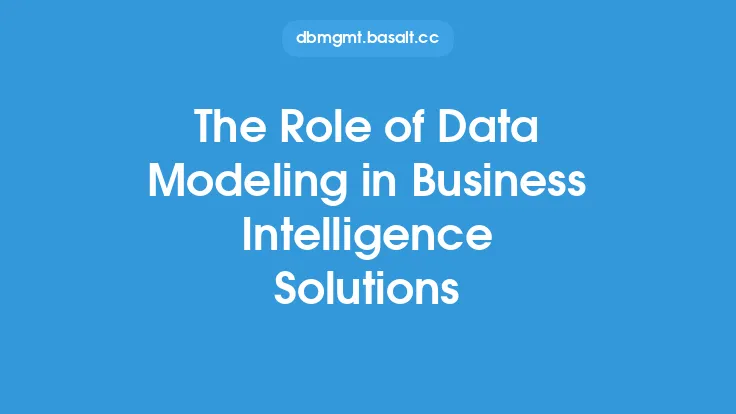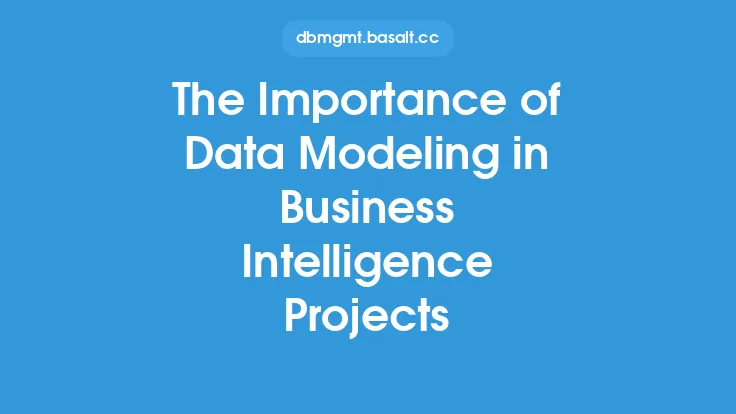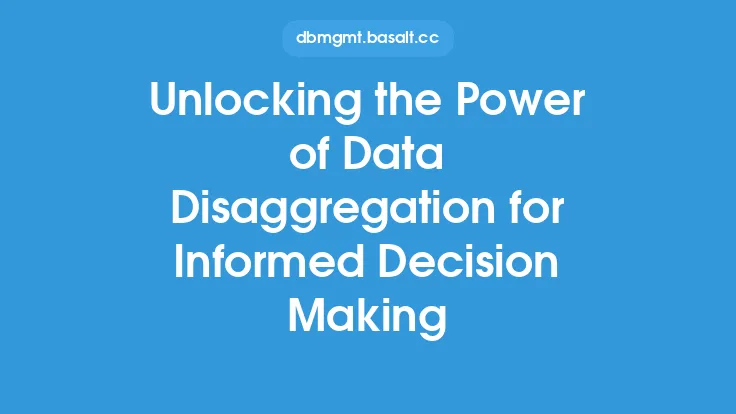When it comes to business intelligence, data plays a crucial role in informing decisions and driving growth. However, the way data is presented and analyzed can significantly impact its usefulness. One often overlooked aspect of data analysis is disaggregation, which involves breaking down complex data into smaller, more manageable components. Disaggregating data can have a profound impact on business intelligence, revealing hidden insights and trends that might otherwise go unnoticed.
Introduction to Data Disaggregation
Data disaggregation is the process of separating aggregated data into its constituent parts. This can involve breaking down data by demographic characteristics, such as age or location, or by other relevant factors, such as time of day or day of the week. By doing so, businesses can gain a more nuanced understanding of their customers, operations, and market trends. Disaggregated data can be used to identify patterns and correlations that might not be apparent when looking at aggregated data alone.
Benefits of Disaggregating Data
Disaggregating data offers numerous benefits for business intelligence. For one, it allows businesses to identify specific areas of strength and weakness. By breaking down data into smaller components, companies can pinpoint exactly where they are excelling and where they need to improve. This can inform targeted marketing campaigns, operational improvements, and strategic decision-making. Additionally, disaggregated data can help businesses to better understand their customers, including their preferences, behaviors, and pain points. This can lead to more effective customer segmentation, personalized marketing, and improved customer satisfaction.
Improved Accuracy and Reliability
Disaggregating data can also improve the accuracy and reliability of business intelligence. When data is aggregated, it can be influenced by outliers or anomalies that skew the results. By breaking down data into smaller components, businesses can identify and account for these outliers, resulting in more accurate and reliable insights. Furthermore, disaggregated data can help to reduce the risk of misinterpretation or misapplication of data. By providing a more detailed and nuanced view of the data, businesses can make more informed decisions and avoid costly mistakes.
Enhanced Data Visualization
Disaggregated data can also enhance data visualization, making it easier to communicate complex insights and trends to stakeholders. By breaking down data into smaller components, businesses can create more detailed and informative visualizations, such as heat maps, scatter plots, and bar charts. These visualizations can help to identify patterns and correlations that might not be apparent when looking at aggregated data alone. Additionally, disaggregated data can be used to create interactive and dynamic visualizations, allowing users to explore the data in more detail and gain a deeper understanding of the insights and trends.
Better Decision Making
Ultimately, the goal of business intelligence is to inform decision-making and drive growth. Disaggregating data can play a critical role in this process, providing businesses with the insights and trends they need to make informed decisions. By breaking down data into smaller components, companies can identify areas of opportunity and risk, and develop targeted strategies to address them. Additionally, disaggregated data can help businesses to evaluate the effectiveness of their decisions, making adjustments and improvements as needed. By providing a more detailed and nuanced view of the data, businesses can make better decisions, drive growth, and stay ahead of the competition.
Real-World Applications
The benefits of disaggregating data can be seen in a variety of real-world applications. For example, a retail company might use disaggregated data to analyze sales trends by location, identifying areas of strength and weakness and informing targeted marketing campaigns. A healthcare organization might use disaggregated data to analyze patient outcomes by demographic characteristics, such as age or ethnicity, and develop more effective treatment plans. A financial institution might use disaggregated data to analyze customer behavior by time of day or day of the week, and optimize their services and operations accordingly.
Best Practices for Disaggregating Data
While the benefits of disaggregating data are clear, there are also some best practices to keep in mind. For one, businesses should ensure that their data is accurate and reliable, and that it is properly cleaned and prepared for analysis. Additionally, companies should consider the level of granularity that is required for their analysis, and ensure that their data is disaggregated to the appropriate level. It is also important to consider the potential risks and challenges associated with disaggregating data, such as data privacy and security concerns. By following these best practices, businesses can unlock the full potential of disaggregated data and drive growth and success.
Conclusion
In conclusion, disaggregating data is a powerful tool for business intelligence, offering numerous benefits and advantages. By breaking down complex data into smaller, more manageable components, businesses can gain a more nuanced understanding of their customers, operations, and market trends. Disaggregated data can be used to identify patterns and correlations, improve accuracy and reliability, enhance data visualization, and inform decision-making. Whether you are a retail company, a healthcare organization, or a financial institution, disaggregating data can help you to drive growth, improve operations, and stay ahead of the competition. By following best practices and unlocking the full potential of disaggregated data, businesses can make better decisions, drive success, and achieve their goals.





